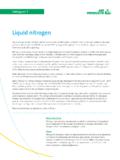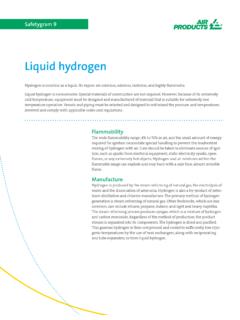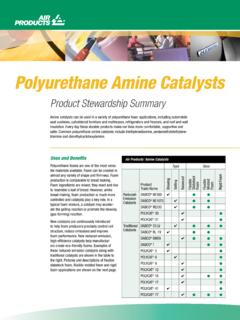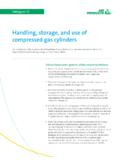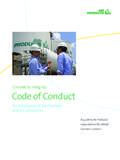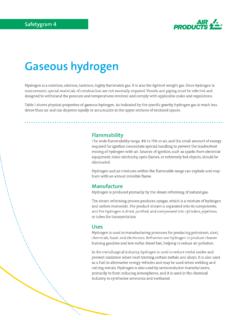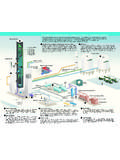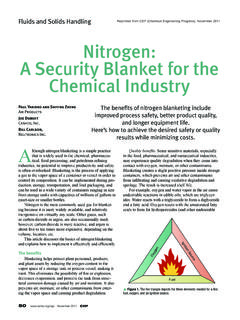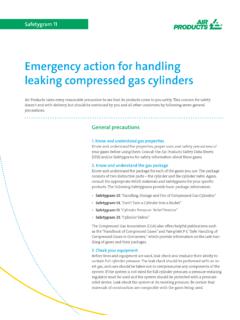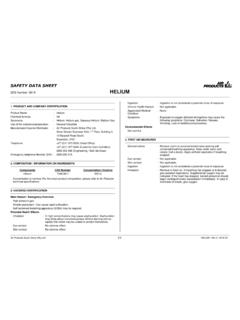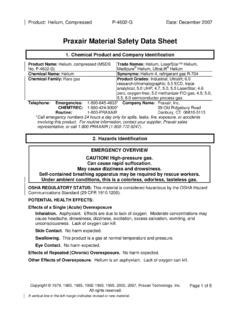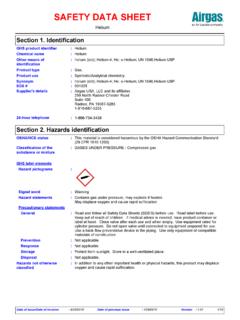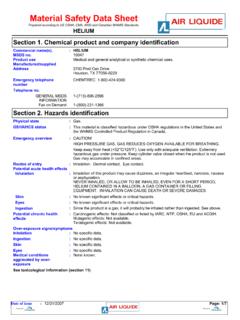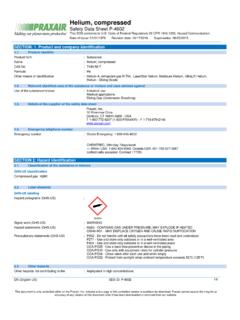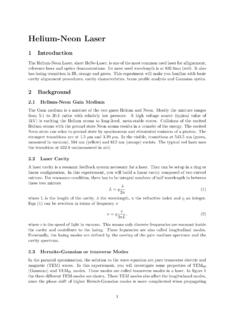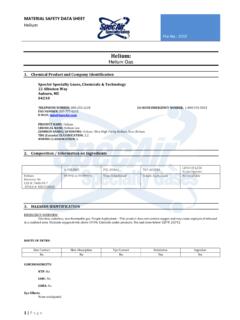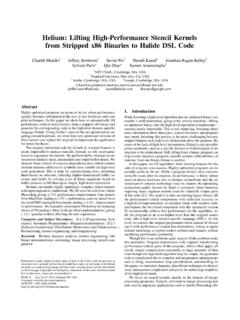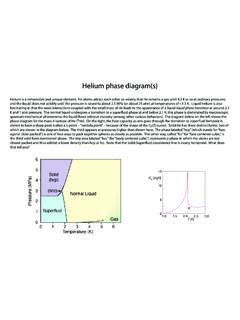Transcription of Liquid helium - airproducts.com
1 Liquid helium is inert, colorless, odorless, noncorrosive, extremely cold, and nonflammable. helium will not react with other elements or compounds under ordinary helium is noncorrosive, special materials of construction are not required. However, materials must be suitable for use at the extremely low temperatures of Liquid helium . Vessels and piping must be selected and designed to withstand the pressure and temperatures involved and comply with applicable codes for transport and heliumManufacture Most of commercial helium is recovered from natural gas through a cryogenic separation process. Normally, helium is present in less than 1% by volume in natural gas. helium is recovered, refined, and liquefied.
2 Liquid helium is typically shipped from production sources to storage and transfill facilities. Tankers, ranging in size from 5,000 to 11,000 gallons, contain an annular space insulated with vacuum, nitrogen shielding, and multilayer insulation. This de-sign reduces heat leak and vaporization of Liquid helium during The extremely low temperature of Liquid helium is utilized to maintain the superconducting properties of magnets in applications such as MRI, NMR spectroscopy, and particle physics research. The main application for gas-eous helium is for inert shielding gas in metal arc and laser welding. helium provides a protective atmosphere in the production of reactive metals, such as titanium and zirconium.
3 Gaseous helium is used as a coolant during the draw-ing of optical fibers, as a carrier gas for chromatography, and as a leak detection gas in a variety of industries. Being both lighter than air and nonflammable, helium is used to inflate balloons and 222 Health effects Being odorless, colorless, tasteless, and nonirritating, helium has no warning properties. Humans possess no senses that can detect the presence of heli-um. Although helium is nontoxic and inert, it can act as a simple asphyxi-ant by displacing the oxygen in air to levels below that required to support life. Inhalation of helium in excessive amounts can cause dizziness, nausea, vomiting, loss of consciousness and death. Death may result from errors in judgment, confusion, or loss of consciousness, that prevents self-rescue.
4 At low oxygen concentrations, unconsciousness and death may occur in seconds and without warning. Personnel, including rescue work-ers, should not enter areas where the oxygen concentration is below unless provided with a self-contained breathing apparatus or air-line more information on oxygen- deficient atmospheres, consult Air Products Safetygram #17, Dangers of Oxygen-Deficient Atmospheres. Extensive tissue damage or burns can result from exposure to Liquid helium or cold helium 1: Liquid helium Physical and Chemical PropertiesMolecular Symbol HeMolecular Weight Point @ 1 atm F ( C)Freezing Point @ 367 psia F ( C)Critical Temperature F ( C)Critical Pressure psia ( atm)Density, Liquid @ , 1 atm lb/ft3 ( kg/m3)Density, Gas @ 70 F ( C), 1 atm lb/ft3 ( kg/m3)Specific Gravity, Gas (air=1) @ 32 F (0 C), 1 atm Gravity, Liquid @ , 1 atm Volume @ 32 F (0 C), 1 atm ft3/lb ( m3/kg)Specific Volume @ 68 F (20 C), 1 atm ft3/lb ( m3/kg)Latent Heat of Vaporization Btu/lb ( kJ/kg)Expansion Ratio, Liquid to Gas, to 32 F (0 C) 1 to 754 Figure 1.
5 Liquid helium Container Design Features30" 0 30 psig GaugePI-1C-1V-1V-3V-2SV-1SV-2SV-3RD-1C-2 C-3C-4 Annulus Rupture Disk8 psig Relief Valve10 psig Relief Valve1 psig Relief ValveLiquid Access Valve (White Handle)Isolation Valve(Green Handle)Vent Valve(Yellow Handle)Note:For 100, 250, and 500 litercontainers, four adaptersizes are provided as shownin Figure 1. Smaller containers,30, 60, and 100 liter, aresupplied with 3/8" and1/2" adapters. 3/8" Adapter1/2" Adapter1/2" FNPT5/8" Adapter3/4" AdapterAnnular Space3 ContainersLiquid helium is stored, shipped, and handled primarily in vacuum-insulated Liquid containers, which are sometimes mistakenly referred to as dewars. Liquid container capacities have been standardized to range from 30 liters to 500 liters.
6 Larger quanti-ties of Liquid helium are transported in tanks with capacities ranging from 5,000 to 11,000 heat leak is always present, va-porization takes place continuously in smaller containers. Rates of vaporiza-tion vary, depending upon the design of the container and the volume of the stored product. Containers are de-signed and manufactured according to applicable codes and specifications for the pressures and temperatures encountered with Liquid helium . Liquid cylindersLiquid helium is most frequently provided to customers in a Liquid cylinder. Figure 1 depicts a typical Liquid container design. The Liquid cylinder consists of two cylindrical vessels, one within the other. The an-nular space is evacuated and contains multilayer insulation.
7 helium is typi-cally withdrawn as a Liquid but may be withdrawn as a gas at low flow rates and pressure. Multiple pressure relief devices are installed on these Liquid containers to protect against 2: Proper Valve PositionsClosedClosedOpenClosedOpen*Open Closed**Closed**OpenV-3 Failure to close these two valves may result in a potential yellow valve is used to presurrize the Liquid container with clean, dry helium to close this valve may cause an ice plug in the neck of the Liquid container,creating a potential in or out of excess pressurebefore, during, and afterproduct transfer as or ShipValve positions after excesspressure has been vented. **GreenHandleValveA 1 psig relief valve SV-3 protects the vessel from overpressure during ship-ment and storage.
8 When the container is placed in service, an isolation valve V-3 is closed to isolate this pressure relief valve. The vessel pressure is now limited by an 8 psig relief valve SV-2. This permits the vessel to be pressur-ized to just under 8 psig to enhance the removal of Liquid helium . The transfer tube has a 10 psig relief valve SV-1 to protect the container from any back-pressure from the filling opera-tion. The outer vessel is protected by a rupture disk user of any cryogenic Liquid con-tainer should be thoroughly familiar with the product and the mechanical workings of the container before us-ing the product. The appropriate Liquid helium valve positions are presented in Figure 2. Valve handles on the con-tainer are color-coded green, yellow, and white.
9 During transportation and storage, the Liquid transfer valve V-1 (white) and the vent valve V-2 (yellow) are closed, while the isolation valve V-3 (green) is open to the auxiliary relief device. 4To transfer Liquid helium , a vacuum- jacketed withdrawal stinger (dip tube) is first inserted through V-1 (white); V-3 (green) is closed and V-2 (yellow) is opened and used to pressurize the Liquid container with clean, dry helium gas. When the container is pressurized to the desired level, the transfer of Liquid helium can begin. Excess pressure in the container can be relieved before, during, and after the Liquid helium is transferred. To vent gas, V-2 (yellow) can be opened. Prior to placing the Liquid container in storage or shipment, V1 (white) and V-2 (yellow) should be placed in the closed position, and V-3 (green) should be placed in the open position.
10 Failure to close V-1 (white) and V-2 (yellow) may cause an ice plug in the neck of the Liquid container, creating a po-tential hazard. Air Products does not recommend the removal or attempt to repair of any component of the Liquid container package. If in doubt about the functionality of any part of the container, please contact Air Products for must be aware of the importance of correct valve position-ing on Liquid helium containers. Loss of product or potentially hazardous conditions may result from improper valve 3: Nonflammable Gas Shipping LabelTransfer lines (vacuum-jacketed line) A vacuum-jacketed (VJ) transfer line should be used to remove Liquid prod-uct from the Liquid containers.
